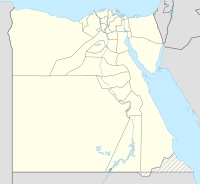Action of Agagia
| Action of Agagia | |||||||
|---|---|---|---|---|---|---|---|
| Part of the Senussi Campaign of World War I | |||||||
 Map showing Agagia |
|||||||
|
|||||||
| Belligerents | |||||||
|
|
|||||||
| Commanders and leaders | |||||||
| Jaafar Pasha |
William Peyton Henry Lukin |
||||||
| Strength | |||||||
| 1,500–1,600 | 1,400 | ||||||
| Casualties and losses | |||||||
| c. 500 | 47 killed 137 wounded |
||||||
|
Agagiya, south-east of Sidi Barrani, Matruh Governorate, Egypt
|
|||||||
The Action of Agagia (also Agagiya, Aqqaqia or Aqaqia) took place east of Sidi Barrani in Egypt on 26 February 1916, during the Senussi Campaign between German- and Ottoman-instigated Senussi forces and British forces. On 11 December 1915, a British column had been attacked at Duwwar Hussein along the Matruh–Sollum track. In the Affair of Wadi Senba, the Senussi were defeated and two days later a Senussi attack at Wadi Hasheifiat was repulsed. The British returned to Matruh until 25 December, then surprised the Senussi at the Affair of Wadi Majid but the Senussi got away. At the Affair of Halazin on 23 January, the Senussi were defeated and again slipped away.
In February 1916, the Western Frontier Force (Major-General William Peyton), was reinforced and a British column advanced west along the coast, to re-capture Sollum in February; en route, a Senussi encampment at Agagiya was spotted by aircraft. On 26 February, the column attacked the Senussi at Agagiya and captured Jaafar Pasha, commander of the Senussi forces on the coast. As the Senussi retreated, they were cut off by a Dorset Yeomanry cavalry charge; the Yeomen lost half their horses and about a third of their riders but dispersed the column, caused about 500 casualties and took 39 prisoners, captured the Senussi baggage train and pursued the survivors into the desert. Sollum was re-occupied by the British on 14 March 1916, which ended the coastal campaign.
The Senussi were a religious sect mainly of Libyan nomads, who had fought the Italians in Libya during the Italo-Turkish War (29 September 1911 – 18 October 1912). Britain declared war on the Ottoman Empire on 5 November 1914 and in the summer of 1915, Turkish envoys, including Nuri Bey, brother of Enver Pasha and Jaafar Pasha, negotiated an agreement with the Grand Senussi, Sayyid Ahmed ash-Sharif, to attack the British in Egypt from the west, during the Ottoman offensive through Palestine against the Suez Canal, known as the Raid on the Suez Canal. By late 1915, many of the British forces in Egypt had been sent to Gallipoli and Mesopotamia, leaving western Egypt garrisoned by the Egyptian coastguard. The Ottomans and Germans delivered modern weapons by submarine to the Senussi. German and Turkish officers were also transported by submarine and landed on 19 May 1915 to the west of Sollum and set up headquarters at Siwa. The Senussi raised 5,000 infantry and other irregular troops, equipped with Ottoman artillery and machine-guns, for campaigns along the coast against Sollum, Mersa Matruh and Da'aba on the way to Alexandria and from Siwa through the "band of oases", Bahariya, Farafra, Dakhla and Kharga, 100 miles (160 km) west of the Nile. The Senussi crossed the Libyan–Egyptian border on 21 November 1915, to begin the coastal campaign.
...
Wikipedia

